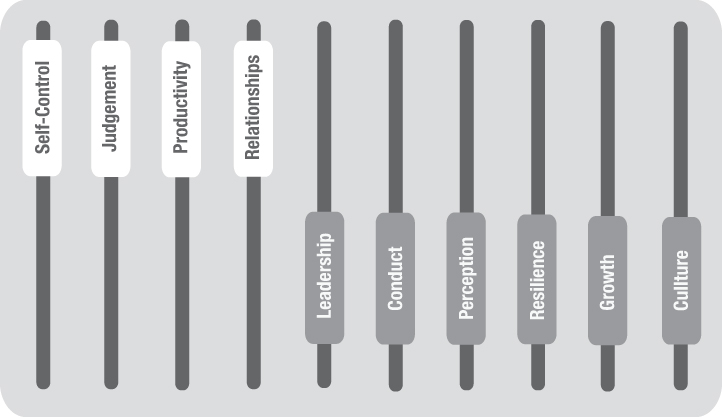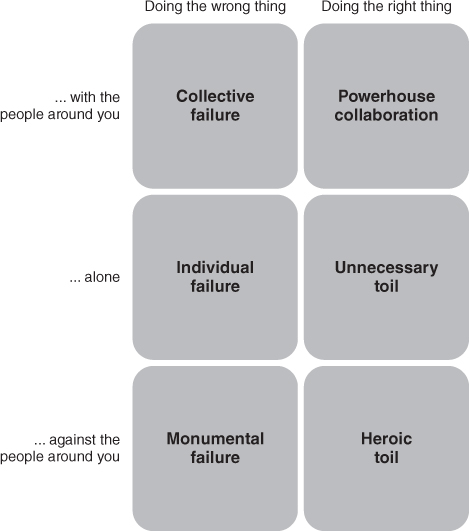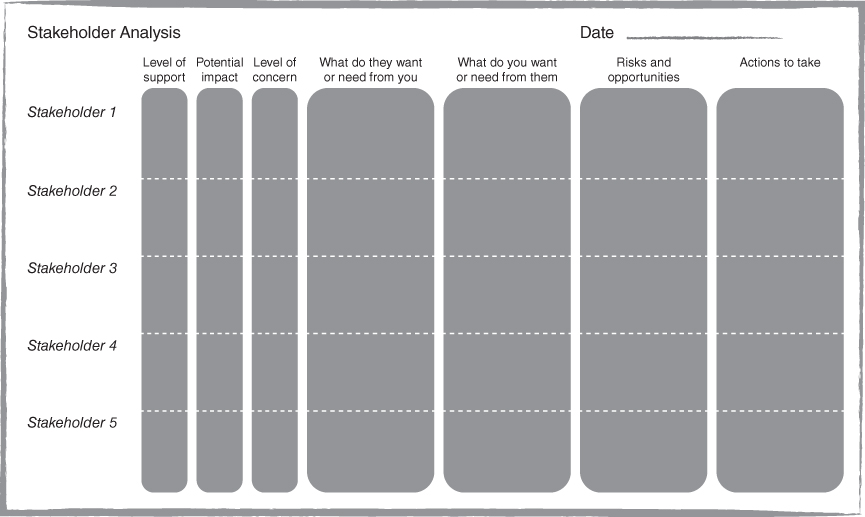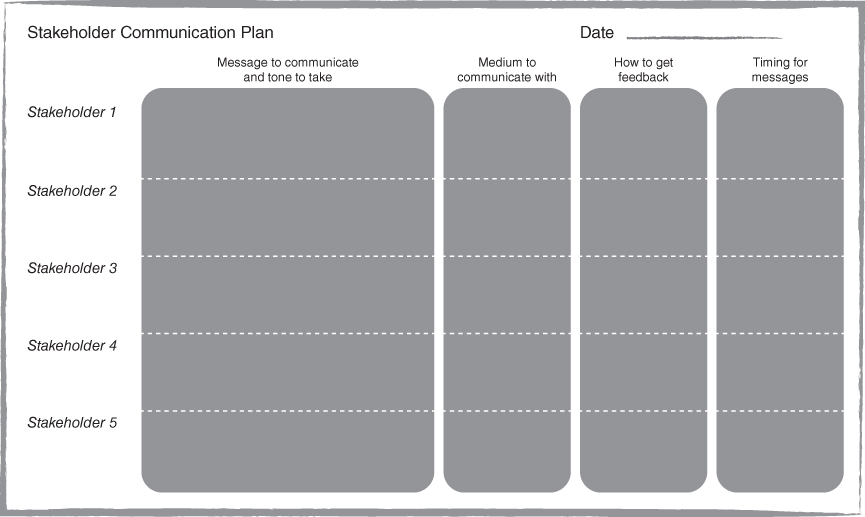Chapter 4
Relationships
Work With the People Around You

When you have achieved your compelling causes, who will get to determine whether you have been successful or not? There will be a whole range of people, and maybe groups and institutions, who have an interest in what you are doing. How will you win their support and commitment, manage their expectations, and counter any resistance or opposition you meet?
You need to build a Powerhouse of connections with people who can help you. Their judgement of your outcomes will determine your true effectiveness. But there is more. To be effective in the face of adversity, a Powerhouse also needs resilience and, whilst this is principally a topic for Chapter 8, human connections are one of the most powerful ways to mitigate the damaging effects of stress.

Powerhouse effectiveness: doing the right things, working with the people around you
Strategic Networking
Strategic networking is the process of transforming your relationships with the people around you into long-term assets.
The quality of your relationships with the people around you has been referred to as your ‘social capital'. Just like other forms of capital; you can grow your social capital through effort and investment. You grow it when you increase trust, links between people and the flow of information. These often happen in those small moments of learning, inspiration, support and motivation, where we feel a sense of shared triumph.
A Powerhouse can aim to build their social capital through constant repetition of four processes.
Process 1: Understand the power structure.
Process 2: Attract people to you.
Process 3: Create your reputation.
Process 4: Build alliances.
Process 1: Understand the Power Structure
A Powerhouse needs to know where the power lies in one's organization and beyond. A simple way to chart this out is to draw a network of contacts between all of the organization's important people, which highlights who influences who else. For the people you most need to influence, find out who influences them. By getting to know those influencers, you will be able to exert indirect influence.
Think about power in all of its forms, not just the power some people have due to their position in the organization. People can have power from their connections to others, their knowledge or expertise, their access to vital resources, or by their strength of personality and character.
And don't forget that a Powerhouse needs to think long term: some of the young, junior colleagues of today will become the powerful players of tomorrow. Invest in these relationships when they see you as a potential help to them, and you can easily build long-term relationships that you can benefit from in years to come. This will always be a portfolio investment. You cannot know which of your four junior colleagues will one day become a CEO, an influential commentator, a middle manager, or adopt an alternative career.
Process 2: Attract People to You
People like people who are:
-
Like themselves.
-
Like they want to be.
-
Familiar to them.
-
Inspiring.
-
Enthusiastic.
-
Helpful.
-
Confident.
-
Make them feel good about themselves.
Each of these offers a way to grow the strength of your magnetic personality. People who set themselves apart are rarely liked unless they have something very special to offer. We like people who get involved and clearly understand us. They fit in socially and culturally, but a Powerhouse may want to dress and act half a notch ahead of their peers, to come across as being at the top of the aspirational pile. The more we know someone, in general, the more we like them. So spend time with the people you want to build relationships with.
We are also attracted to confidence and inspirational behaviours, so walk tall, smile and be prepared to articulate a positive vision for what can be. Be enthusiastic and helpful to people and make them feel good about themselves by endorsing their ideas and complimenting them on their achievements. Be generous with praise and thoughtful about what you criticize, so that everything you say will make me think that that I am better off for having heard it.
Process 3: Create Your Reputation
'You can't build a reputation on what you are going to do.'
Henry Ford
A Powerhouse knows that reputations are built on effectiveness. This is not about impressing people in the hope that they will help you in the future. It is about finding ways to be useful to the people you want to influence, so they will remember that they can depend on you.
Think about what reputation you want, so you can put your emphasis in the right place. For example, you may want a reputation as an ideas-generator, a morale-booster, a get-things-done person, as always receptive and positive, or as a source of knowledge and insight. You cannot develop all of these, but you can put your efforts into some of them and work hard to create a reputation that fits your personality and attracts and retains the right people.

The four stages of building alliances
Process 4. Build Alliances
Building long-term professional alliances is a four-stage process. As you progress from one stage to the next, you convert me first into an ally, then into a core ally, then to your collaborator, and finally to your partner.
Stage 1: Jump-Starting the Alliance
The way you treat someone right at the start of a professional relationship will dictate not just whether, but how quickly, you can build an alliance. Four things you can do are:
- Presume the other person has earned their position in the organization, and trust their expertise and knowledge.
- Agree on a shared set of goals and outcomes, and on how you will share any recognition and rewards from working together.
- Define clear roles for each of you, and how you will interact to share information and collaborate where your roles intersect.
- Focus on action and making progress. Take responsibility for your tasks and respond quickly to requests for help or support.
Stage 2: Deepening the Trust and Inter-Dependence
Perhaps the strongest way to deepen trust is the ‘paying it forward' principle. Doing un-asked-for favours and acting generously to other people will not only build their trust, but also increase their willingness to help you in the future.
Exchanging favours is also a way that we humans enhance our social status, becoming more influential with our peers. This will give you greater social capital. But a Powerhouse has one objective at the top of their mind: effectiveness. And research by Francis Flynn at Stanford University showed that workers who did slightly more giving of favours than receiving were more productive, in terms of completion of tasks, meeting of deadlines and avoidance of mistakes.
When it comes to favours, it is better to give than to receive.
… as long as you don't skew the balance too far, and end up becoming a serial helper with no time for your own work. Choose what favours to grant and then have the confidence to ask for favours when you need them. People around you will sense the balance of your favour giving and receiving and, if they know you to be generous with your time and support, they will be well disposed to you when you need help.
Stage 3: Entrenching the Alliance by Working Together
The nature of collaboration is openness to do whatever it takes to achieve our agreed outcome. It requires high levels of mutual trust and commitment to a shared compelling cause. There is no ‘my job and your job; my reward and your reward': there is just ‘our jobs and our rewards'.
The benefits, of course, go way beyond the relationship, giving greater problem solving capacity, enhanced judgement and decision-making, and more effective working to deliver greater productivity. The cost is the time and energy it takes to reach and maintain this level of cooperation.
Stage 4: Extending the Alliance Outwards
Once you have created a number of collaborative relationships, a Powerhouse will have the skills to extend this throughout your organization. If you can become the sort of person who lifts up other people's mood, encouraging and energizing them, then you will see the people around you become more motivated and productive.
When you can engage others like you, you can create Positive Energy Networks (PENs) where people find support for their own Powerhouse performance. Linking into a PEN makes people feel energized, creative and powerful. The ultimate social capital comes to those bright suns who sit at the centre of a solar system of Powerhouse performers.
A Tactical Campaign
For short-term stakeholders in your compelling causes, you need a simple, pragmatic and less strategic approach.
Your time is limited and, much as you may want to, you will not be able to invest the time and effort to create long-term relationships with all the people you need to engage, work with and win the support of. For the more peripheral or short-term stakeholders in your compelling causes, you need a simpler, more pragmatic and less strategic approach. Once you establish a new outcome to pursue, follow these three steps to engaging with them constructively.
Step 1: Identify and analyse the interested parties.
Step 2: Plan and manage your campaign.
Step 3: Put your network to work.
We will look at each step in turn.
1. Identify and Analyse the Interested Parties
First, list everyone who has any interest in your compelling cause and its outcome. These may be people affected by what you are doing or people who can in some way affect your outcome or your choices along the way. These are your stakeholders. Now analyse them, using a simple table similar to the following.

Stakeholder analysis table
This approach will help you to prioritize your actions. The two obviously important groups are your anchor supporters, who are high on levels of support, potential impact and concern, and your potential saboteurs, who also have high levels of concern and impact, but are opposed to what you are doing. A third important group are your fence-sitters: people with moderate to high levels of concern and potential impact, but who have not yet made up their mind whether to support or oppose you.
2. Plan and Manage Your Campaign
The actions to take column in the previous template is where you can record your first thoughts about strategy for each stakeholder. Now put together a communication plan like the one in the following table.
Remember:
Communication is not just about information: you need to win over hearts as well as minds.
Design messages that appeal to the three factors we looked at in the section The Poetry of Persuasion in Chapter 2: trust, reason and emotion. Think carefully about the tone you wish to adopt for each stakeholder: do you want to be conciliatory or assertive, do you want to raise questions or dictate answers, or do you want to request help or demand support? Also decide which medium will appeal best to each stakeholder, balancing the speed and ease of some media, like email, with the greater power of others, like face-to-face meetings.
And don't forget the importance of getting feedback, so you can re-evaluate your strategy and plans if they are not producing the results you want.

Stakeholder communication plan
Put Your Network to Work
If you are successful in engaging your network of stakeholders, you will have a powerful resource to call upon for guidance, support and help.
Giving people a say in your plans and strategy will give them a sense of control. We tend to rebel when we feel we don't have control, so giving some, where it suits you, will reduce the likelihood of resistance in other areas.
Relationships: 7 Powerhouse Pointers
- Strategic networking is the process of transforming your relationships with the people around you into long-term assets.
- To build a strategic network, you need to understand the power structure, attract people to you, create your reputation and build alliances.
- When it comes to favours, it is better to give than to receive.
- 'You can't build a reputation on what you are going to do.’ Henry Ford.
- For short-term stakeholders in your compelling causes, you need a simple, pragmatic and less strategic approach.
- To engage with short-term stakeholders, you should identify and analyse the interested parties, plan and manage your campaign, then put your network to work.
- Communication is not just about information: you need to win over hearts as well as minds.
